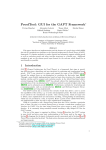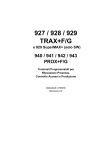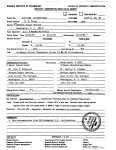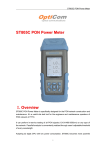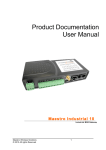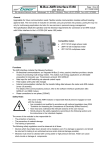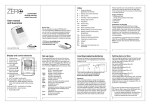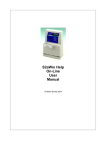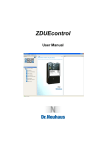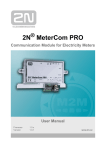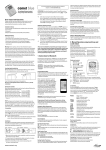Download Vladimir Dimcev, Cvetan Gavrovski Keywords: automatic metering
Transcript
ELECTRONICS’ 2005 21 – 23 September, Sozopol, BULGARIA AUTOMATIC METERING SYSTEM FOR ELECTRICITY Vladimir Dimcev, Cvetan Gavrovski Department of Electrical Measurements, University Ss. Cyril and Methodius, Karpos 2 b.b., 1000 Skopje, Macedonia, phone: +389 70 275 543, e-mail: [email protected] The process of liberalization and deregulation of electricity generation and distribution, as well as introduction of regional electricity markets all around the world impose new requirements to the automatic metering systems for electricity. Following new developments in the mentioned area, as well as planned introducing of South-East European electricity market, the two Macedonian companies dealing with the electricity Electric Power Company of Macedonia (ESM) and Macedonian Electric Power System Operator (MEPSO) introduce new fully automatic measuring systems for electricity. The systems will acquire data from all meters installed in generation, transmission and distribution facilities within both companies and from the meters in the industry. Also around 6000 meters will be changed with new digital meters and half of them have possibility for remote reading. The two systems have identical three level architecture communication devices, hardware and software. The differences between systems are only the size and the capacity of hardware and software licenses, which is on the ESM side. The hardware of metering systems comprises three servers, for data acquisition and processing, for database management and for visualization of the meter data. On the communication side there are three types of modems (PSTN, GSM and ISDN) which communicate with the meters. The software level meets the requirements of the liberalized energy market. Keywords: automatic metering, remote acquisition, electricity meters 1. INTRODUCTION The liberalization of the energy market poses new challenges for energy supply utilities: quick availability of consumption data is becoming increasingly important in numerous business processes of energy companies. While the billing process retains its central importance, metering data is also increasingly required for other important processes, such as power consumption analysis, forecasting, trading and accounting management. Qualified customers have opportunity to access their power consumption data via Internet. Depending on the degree of liberalization of the market, a controlled exchange of data takes place between the individual players according to the market regulations. The increased utilization of metering data in a wide variety of business processes imposes various demands on the deployed remote metering systems, such as: ‡ Availability: the timely and reliable delivery of perfect-quality metering data requires redundant, fault tolerant systems. ‡ Scalability: the deployed systems must be able to grow with the increasing data volume and rising process requirements. ELECTRONICS’ 2005 21 – 23 September, Sozopol, BULGARIA ‡ Flexibility: the unfolding radical changes in the market organization will create new demands with regard to data exchange and interfaces for which the system should be equipped. ‡ Security: technical concepts that have been adapted to the company’s organization guarantee the security of the acquired and processed consumption data. ‡ Data integrity: the correctness of the data used must be guaranteed and processing steps must remain traceable all the time. All these dramatic changes in the energy sector, as well as the planned start-up of South-East European electricity market in the very near future, force the two Macedonian companies dealing with the electrical energy: Electric Power Company of Macedonia (ESM) and Macedonian Electric Power System Operator (MEPSO), to introduce new automatic metering systems for electricity. In parallel old induction meters within both companies, as well as meters in industry will be replaced with new digital meters. The total number of changed meters will be 6000, half of them will have communication module. The new metering systems for ESM and MEPSO cover and fulfill following main goals: - Introducing new metering technologies at all voltage levels; - Increased measurements accuracy at the interconnection and energy exchange points; - Remote data acquisition for registration of received and supplied electricity and power; - Conditions for developing of electricity market at local and regional level; - Reduced time and maintenance costs of measuring devices. This bold project is supported by donation of Swiss government throw Swiss State secretariat for Economic Affairs (seco). 2. HARDWARE METERING SYSTEM DESCRIPTION To achieve the required performance of the metering system and to provide some reserves for future expansion of number of acquired meters, a multi server system concept was accepted. There are three dedicated servers: for data acquisition and processing, for data presentation and reporting and database server. The servers include a RAID (Redundant Array of Independent Disks) configuration for data storage (RAID 1 for operating system and applications and RAID 5 for database). The overview of the system is shown on Figure 1. Data acquisition/data processing server communicates with Etherlite Terminal server, which is connect to the PSTN, GSM or ISDN modems. The modems acquire data from remote meters. These devices are connected directly to the company LAN and allow central location independent operation. In case some of communication channels to a meter have been interrupted, the data could be acquired locally from the meter with laptop and imported into system. ELECTRONICS’ 2005 21 – 23 September, Sozopol, BULGARIA On the transmission level, MEPSO system gains the energy and load data from different types of measuring points like: power production plants, international interconnection points, high consumption industrial users (direct users on 110kV level), and exchange points with distribution utilities. While ESM system gains energy and load data from exchange points between transmission ‡ distribution and from significant industrial users (on 10kV and 0,4kV level) which meters are equipped with communication device. All acquired and processed data are saved in database server which function is only for storage/backup of data. The third server is for data presentation and reporting and also acts as Internet information system ‡ web server. Big or qualified customers could see their consumption and energy data, general data and other information via Internet. For security reason it contains its own database, which is being updated frequently from the main database. Meter data is transferred in “one way” from the main database to the web server database. Also network security concept ‡ Firewall is implemented to protect internal companies network (LAN) from outside users of web server (see Fig.1). Figure 1. Metering System for Transmission level ELECTRONICS’ 2005 21 – 23 September, Sozopol, BULGARIA All servers have following configuration: dual processor Intel Pentium IV 2.80 GHz, RAM memory 2 GB, hard disk drives SCSI, 2 x 18 GB for operating system with RAID level 1 and 4 x 72 GB with RAID level 5, controllers SCSI/RAID. 3. OVERVIEW OF A SOFTWARE CONCEPT 3.1 Acquisition and processing software All measured data by the meters, active and reactive energy, load profiles, power, voltages, currents, etc., are acquired automatically by acquisition software in predefined time intervals or, if necessary, manually. For fast reading of data, meters in same facility (power plant or substations) are combined into clusters or acquisition groups (Fig. 2). GSM module "Master" meter PSTN Communication frontend RS485 Meter cluster in a measuring point Data acquisition system Figure 2. Example of meters acquisition group The data acquisition software supports the most important communication protocols like: IEC1107, DLMS, SCTM, VDEW2.0, FNP, etc. Energy data and load profile in the meters are stored according to universal data storage standard OBIS Identifier system (EN 62056-61). The read data from meters is initially stored as raw data then converted into a single format for further processing. The software does additional jobs like: synchronization of meters time with master time, communication diagnosis, log of events, error groups for not acquired data. One of very important function of software is the data validation. Data validation becomes indispensable, because only verified data can be passed to other players in liberalized market. If the data is incorrect or incomplete, the software automatically fills it up with substitute values using various algorithms. Plausibility checking of data is made with four different tests: test for missing values, meter value and user status check, test for exceeded limit values and tolerance test (percentage deviation between two load profiles). The second function of data acquisition software is processing of data throw predefined calculation tables and reports. The creation of reports is supported by MS Excel and can contain tables and graphs. Reports could be exported in various formats (GUI, HTML, XLS, TXT) and distributed via printer, file or e-mail. The software allows handling of auxiliary values which are manually entered values used for load profile calculations. There are four types of auxiliary values: constant values for a long period (e.g. consumer pays a penalty for overconsumption), constant value for a short period (contractual import of energy), tariffbased auxiliary values (for values that change according to a tariff agreement) and integration period based auxiliary values (values that change each integration period). ELECTRONICS’ 2005 21 – 23 September, Sozopol, BULGARIA Tariffication is very flexible and tariff rate may be changed as frequently as the defined integration period allows. For example, for an integration period of 15 minutes, the tariff rate may be changed at 15 minutes intervals. 3.2 Data presentation and Internet information software This software installed in the third server is an Internet based information medium that gives access to the customers to their energy data. The data provided on the Internet portal is general (tariff models, prices and other information) and specific information for each user, like spending of energy, load profiles (example of load profile is given on Fig. 3), etc. Figure 3. Example of load profile The data is protected by a Firewall and can only be transferred in one direction via the Internet – from the data server to the user. Actually the Internet server has a synchronized database copy of the main database which is located in the data server. All presentations and reports are generated from this copy. Data transfer from data server is extremely fast, because only the data and no graphics is transfer. The graphics are generated in the Captive Browser, where each user is free to define individual settings. Numerous intuitive functions and settings enable users to create highly personal calculations and views (tables and graphs) according to their specific needs. The data could be transfer to all MS Office and comparable products via clipboard or file export, different formats are supported like, XML, HTML, TXT and various picture formats. 4. ACQUISITION ON DISTRIBUTION LEVEL The Distribution level in ESM is organized in 28 local distribution utilities. All 28 utilities measure and bill the energy that they supply to their respective consumers. Every distribution utility is equipped with a workstation and appropriate software used for data collection, computing and transfer of data to the central system (Fig. 4). The bigger industrial consumers have meters with communication modems, which send data directly to the central system, while the meters within smaller consumers are read with Hand Held Terminals by optical interface or manually. ELECTRONICS’ 2005 21 – 23 September, Sozopol, BULGARIA Figure 4. Metering system for distribution level In the Distribution office, the data from HHT are downloaded to the workstation in an ASCII format. The workstations then communicate with central system for further administration of the data. All elements of the both systems have modules for automatic synchronization of time (day and hour, winter and summer time). The central system is synchronized throw DCF77 radio module; while workstations are synchronized every time they are connect to central system. Hand held terminals are then synchronized from workstations. There is no possibility for manual synchronization for any component of the system. 5. CONCLUSIONS The paper presents new automatic data acquisition systems for remote meter reading implemented in Macedonian power companies, ESM and MEPSO. Along the introducing of the new systems, the old induction meters with accuracy classes of 0.2, 0.5 and 1.0 will be replaced with digital meters and half of them are with communication modems. The hardware of systems comprises three servers, for data acquisition and processing, database storage server and Internet server. Communication with the meters is done throw PSTN, GSM and ISDN modems. The system software is tailored according the requirements of the liberalized energy market. 6. REFERENCES [1] Landis & Gyr: Converge Meter Data Warehouse System Description, 2001. [2] Technical Specifications for Numerical Meters ZMD300/ZxD400, Landys & Gyr, 2003. [3] Elster Messtechnik GmbH, AlphaSet 3 User Manual, 2005. [4] T.P. Morrison, “The art of computerized measurement”, Oxford Science Publications, Oxford, 1997.







